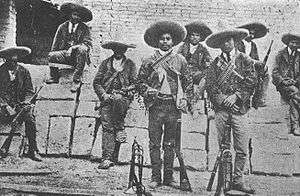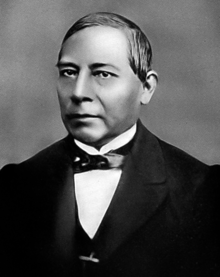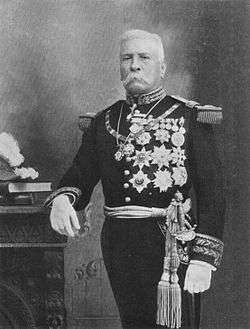Rurales
| Guardia Rural | |
|---|---|
 A detachment of Rurales in field uniform during the Diaz era. | |
| Active |
1861 - 1914 (first stage), 1920s-1950s (second stage), 1970s-present (modern) |
| Country |
|
| Branch |
|
| Type | Gendarmerie |
| Nickname(s) | Rurales |
| Engagements |
Historic mounted police force:
Cristero War Mexican War on Drugs |
Rurales (Spanish for "Rurals") is a Mexican term used to describe two different government forces. The best known is the Guardia Rural (Rural Guard), founded by President Benito Juárez in 1861 as a rural police force controlled by the president and expanded by President Porfirio Díaz (r. 1876-1911), a former army general, and used as an effective force of repression. It was a counterweight to the Mexican Army, whose nineteenth-century generals often overthrew the president. The rurales were dissolved during the Mexican Revolution. There is now a modern Cuerpo de Defensa Rural (Rural Defense Corps): members of a part-time voluntary militia, used to support Federal forces.
Rural Guard
The Guardia Rural was established as a federal constabulary by the Liberal regime of Benito Juárez in 1861. This mounted rural police force became best known during the long rule of President Porfirio Díaz (1876–1911).
Origins

As originally constituted under Juárez the Rurales lacked the numbers and organization to effectively control the banditry widespread in Mexico during the 1860s and 1870s. The concept of an armed and mobile rural police organized on military lines, was derived from Spain's Civil Guard ("Guardia Civil"). Established in 1844 the Spanish Guardia Civil had quickly won a reputation as an effective but often oppressive force.
On May 6, 1861 four corps of Rural Police were authorized by the Juárez government; each having an establishment of 20 officers and 255 other ranks. Recruitment was intended to be by voluntary enlistment. Pay was set at a higher level than that of the conscript based army. Control of the new force was divided between the Ministers of the Interior and of War - a policy intended to maintain a balance of power within the government.[1]
French Intervention
The existing Corps of Rurales was absorbed into the Republican Army and irregular forces opposing the French intervention of 1862–1867. However the Imperial regime of Archduke Maximilian (1862–1867) created a parallel force known as the Resguardo, which by October 1865 numbered 12,263;[2] indicating that the concept of a rural mounted police force had become well established. Following the Republican victory, Los Cuerpos Rurales were re-established.
Under Porfirio Diaz

The rurales were reestablished in 1869 as part of the reconstruction of the Mexican Republic following the Franco/Maximilian episode. The corps was placed under the Ministro de Gobernación and specifically tasked with providing mounted patrols for rail and road links, escorting gold and other valuable shipments, providing support for the Federal Army when called upon, and ensuring security when local elections were held.[3]
By 1875 the corps numbered about one thousand members, organized in forty-two squads primarily responsible for patrolling the Mexico valley region. While their performance was uneven - with charges being made of both aggressive behavior against the public and slackness in enforcing their responsibilities - the rural guards had been successful in eliminating a number of bandit groups.[4]
Following his accession to power in 1877, President Porfirio Díaz expanded the Rurales to nearly 2,000 by 1889 as part of his programme of modernization and (eventually) repression. Initially some captured bandits were forcibly inducted into the Rurales, as had been the case under Juárez. The system of recruitment however subsequently became a more conventional one of volunteer enlistment. Officers were usually seconded from the Federal Army. The Rurales were heavily armed; carrying cavalry sabers, Remington carbines, lassos and pistols.[5] They were divided into ten corps, each comprising three companies of about 76 men.

The Porfirian regime deliberately fostered the image of the Rurales as a ruthless and efficient organization which – under the notorious ley fuga ("law of flight") – seldom took prisoners and which inevitably got its man. However, research by Professor Paul J. Vanderwood during the 1970s involving detailed examination of the records of the corps indicated that the Rurales were neither as effective nor as brutal as regime publicists had suggested. The daily pay of 1.30 pesos was not high and up to 25% of recruits deserted before completing their four-year enlistments. This term of service was extended to five years after 1890. Only one rurale in ten re-enlisted after completing his first term; a low proportion that may have been influenced by slow and limited promotion.[6]
Never numbering more than about 4,000 men and located in small detachments, the Rurales were too thinly spread to ever completely eliminate unrest in the Mexican countryside. They did however impose a superficial order, especially in the central regions around Mexico City, which encouraged the foreign investment sought by Díaz and his científico advisers. To a certain extent the regime saw the Rurales as a counterweight to the much larger Federal army and in the later years of the regime they were increasingly used to control industrial unrest, in addition to the traditional task of patrolling country areas.[7] While in theory a centralized organization, the rural guards often came under the direct control of local politicians or landowners.[8]
The Rurales achieved a high profile internationally,[9] rather like that of the Royal Canadian Mounted Police or the Texas Rangers, whose roles they paralleled. They wore a distinctive grey uniform braided in silver, which was modelled on the national charro dress and included wide felt sombreros, bolero jackets, tight fitting trousers with silver buttons down the seams, and red or black neckties.[10] Senior officers wore elaborate rank insignia in the form of Austrian knots and sombrero braiding, which cost hundreds of pesos. The corps number appeared in silver on both the headdress and a leather carbine cross-belt.[11]
This dress, their frequent involvement in ceremonial parades and their general reputation, invariably drew the attention of foreign visitors to Mexico during the Porfiriato. They were variously described as "the world's most picturesque policemen" and "mostly bandits".[12] The former may have been true but the latter was a distorted memory of the rough-and-ready early days of the corps. Some of the Mexican states maintained their own rural mounted police forces and a separate city police force operated in Mexico City,[13] but none matched the Federal Rurales in notoriety or glamour.
| A graphical timeline is available at Timeline of the Mexican Revolution |
Under Francisco Madero and Victoriano Huerta
During the early stages of the Mexican Revolution of 1910, detachments of Rurales served alongside Federal troops against the rebel forces. While retaining an elite image (one revolutionary fighter commented to a US writer that Rurales never surrendered "because they are police"), the force was too weak in numbers and dispersed in deployment to play a decisive role.
After the overthrow of Díaz in 1911, the Rurales continued in existence under Presidents Francisco I. Madero (1911–1913) and Victoriano Huerta (1913–1914). Madero left the force essentially unchanged, although introducing legislation intended to prevent corpsmen, other than senior officers, from carrying out summary executions without due trial process.[14] In practice the induction of large numbers of Maderista fighters on a temporary basis while awaiting discharge simply diluted such efficiency as the corps had retained. Huerta saw a more central role for the Rurales and directed officers of the Corps to murder Madero[15] after the "Ten Tragic Days" of 1913. He then proposed to expand the existing units into a field force of over ten thousand men serving alongside the regular Federal troops. Recruiting and desertion problems prevented this ever becoming a realistic project. The remains of the Guardia Rural were finally disarmed and disbanded during July–August 1914, along with the old Federal Army, when Huerta fled into exile.[16]
The Rurales in fiction
- The Rurales of the Diaz era make an appearance in O. Henry's short story, "Hostages to Momus". O. Henry, writing through the first-person narration of the character Tecumseh Pickens, gives a colorful sketch of the Rurales:
- "Rurales? They're a sort of country police; but don't draw any mental crayon portraits of the worthy constable with a tin star and a gray goatee. The rurales---well, if we'd mount our Supreme Court on broncos, arm 'em with Winchesters, and start 'em out after John Doe et al. we'd have about the same thing."
- In his novels "The General From the Jungle" and "Rebellion of the Hanged", the German/Mexican writer B. Traven describes in detail the role of the rurales during the early years of the 20th century; as an instrument of repression against the exploited peasantry and mahogany cutters of the far south of Mexico.
- In his film Viva Zapata John Steinbeck portrays the rurales guarding a hacienda, escorting a prisoner, breaking up a riot in a village square, and suppressing rural unrest.[17]
- Early in One-Eyed Jacks, a Western film set in the 1880s, American bank robbers played by Marlon Brando and Karl Malden are pursued by Rurales.
- Rurales are engaged in a battle with Texans pursuing a band of kidnapping banditos into northern Mexico in Gordon Rottman's 2014 novel, The Hardest Ride.
Rural Defense Corps
The modern Rurales are a part-time militia called the Cuerpo de Defensa Rural (Rural Defense Corps).
Origins
Originally formed as village self-defence groups during the agrarian disturbances of the 1920s. They do not have any functions that parallel those of the paramilitary mounted police force of the 1861–1914 era. This corps was formally organized under army jurisdiction according to the Organic Law of 1926. Its origins, however, date back to the period when the revolutionary agrarian reform program was first implemented in 1915. In efforts to protect themselves against the private armies of recalcitrant large landowners, rural peasants organized themselves into small defense units and were provided weapons by the revolutionary government. Until 1955 enlistment in the Rural Defense Force was restricted to peasants working on collective farms (ejidos). After 1955 participation in the Rural Defense Force was expanded to include small farmers and laborers. All defense units, however, were attached to ejidos, possibly as a means to guarantee control.
Modern Rurales
The Rural Defense Force (Rural Police Force) numbered some 120,000 in 1970, but was being phased out in the 1990s. The IISS's The Military Balance listed the corps as having only 14,000 members in 1996. The volunteers, aged eighteen to fifty, enlist for a three-year period. Members do not wear uniforms or receive pay for their service but are eligible for limited benefits. They are armed with outmoded rifles, which may be the chief inducement to enlist. Rudimentary training is provided by troops assigned to military zone detachments.
The basic unit is the pelotón of eleven members under immediate control of the ejido. Use of the unit outside the ejidos is by order of the military zone commander. One asset of the corps is the capacity of its members to gather intelligence about activities within the ejidos and in remote rural areas seldom patrolled by military zone detachments. Corps members also act as guides for military patrols, participate in civic-action projects, and assist in destroying marijuana crops and preventing the transport of narcotics through their areas.
Currently Rural Defence Force members are being utilized in the Mexican war on Drugs. This is the case in the State of Michoacán, where the Government has attempted to restrict civilian vigilantism (such as the creation of unregulated armed security groups) by deploying rurales against local drug cartels.[18][19]
See also
References
![]()
- ↑ Paul J.Vanderwood, Disorder and Progress: Bandits, Police, and Mexican Development, Lincoln: University of Nebraska Press 1981, p. 51.
- ↑ Rene Chartrand, page 23 "The Mexican Adventure 1861-67", ISBN 1-85532-430-X
- ↑ Article "Rurales": Britanica.com
- ↑ Paul J.Vanderwood, page 59 "Disorder and Progress - Bandits, Police, and Mexican Development", ISBN 0-8420-2438-7
- ↑ Paul J.Vanderwood, page 101 "Disorder and Progress - Bandits, Police, and Mexican Development", ISBN 0-8420-2438-7
- ↑ Paul J. Vanderwood, page 101 "Disorder and Progress - Bandits, Police, and Mexican Development", ISBN 0-8420-2438-7
- ↑ Page 120, "Disorder and Progress - Bandits, Police and Mexican Development", Paul J. Vanderwood, ISBN 978-0-8420-2439-6
- ↑ Pages 29-30, "The Mexican Revolution 1910-20", P. Jowett & A de Quesada, ISBN 0-8420-2439-5
- ↑ Paul J.Vanderwood, page xiv "Disorder and Progress - Bandits, Police, and Mexican Development", ISBN 0-8420-2438-7
- ↑ page 68, "The City of Mexico in the Age of Diaz", Michael Johns, ISBN 978-0-292-74048-8
- ↑ page 56, "The Mexican Revolution 1910-20", P. Jowett & A de Quesada, ISBN 0-8420-2439-5
- ↑ Page 28, "The Mexican Revolution 1910-20", P. Jowett & A de Quesada, ISBN 0-8420-2439-5
- ↑ pages 71-73, "The City of Mexico in the Age of Diaz", Michael Johns, ISBN 978-0-292-74048-8
- ↑ Page 162, "Disorder and Progress - Bandits, Police and Mexican Development", Paul J. Vanderwood ISBN 0-8420-2439-5
- ↑ Montes Ayala, Francisco Gabriel (1993). Raúl Oseguera Pérez, ed. "Francisco Cárdenas. Un hombre que cambió la history". Sahuayo, Michoacán: Impresos ABC.
- ↑ The Mexican Revolution 1910-20, P. Jowett & A. de Quesada ISBN 1-84176-989-4
- ↑ John Steinbeck, pp. 50, 60, 111 and 157 "Zapte The Little Tiger", ISBN 0-434-74025-X
- ↑ http://www.excelsior.com.mx/nacional/2014/05/10/958523
- ↑ http://www.jornada.unam.mx/2014/01/28/politica/009n1pol
Further reading
- John W. Kitchens, "Some Considerations on the "Rurales" of Porfirian Mexico," Journal of Inter-American Studies," (1967) 9#3 pp 441–455 in JSTOR
- Paul J. Vanderwood. Disorder and Progress: Bandits, Police, and Mexican Development (1992) online
- Paul Vanderwood, "Genesis of the Rurales: Mexico's Early Struggle for Public Security," Hispanic American Historical Review (1970) 50#2 pp. 323–344 in JSTOR
- Reglamento para el Servicio de la Policía Rural Junio 24 de 1880 Imprenta del Gobierno en Palacio México 1880